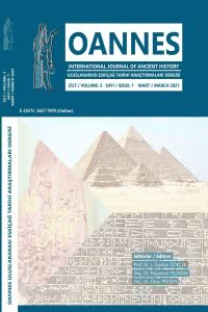Antik Kaynaklarda Hellen Resim Sanatı
Plinius Doğa Tarihi (Naturalis Historia) adlı eserinin 35. Kitabında resim sanatını detaylı bir şekilde ele almıştır. Burada, resim sanatının Mısırlılar tarafından icat edildiğini, sonra Helenlere geçtiğini bildirmektedir. Pausanias, MÖ 5. yüzyılda, Thasoslu Polygnotos’un Delphi’deki Knidos toplantı yapısı (Leskhe) için yaptığı iki resmi tanımlamıştır. Aristoteles de Polygnotos ile Zeuksis’i karşılaştırarak Polygnotos’un hüznü yansıtmadaki başarısını vurgulamıştır. Vitruvius, Atinalı Agatharkhos tarafından yapılan sahne dekorunun başarısının Anaksagoras ile Demokritos’un sanatını etkilediğini yazmaktadır. Herakleialı Zeuksis ile Ephesoslu Parrhasios sanatsal düzeyi yükseltmişlerdir. Dönemin en ünlü ressamlarından biri olan Apelles aynı zamanda Büyük İskender’in de saray ressamıdır. MÖ 5. yüzyıl sonu ve 4. yüzyıl başlarında etkin olan sanatçılar Eupompos, Makedonyalı Pamphilos ile enkaustik resmi geliştiren öğrencisi Sikyonlu Pausias, Thebaili Aristeides ile Atinalı Nikias’tır. Antik Hellen resimlerinin bazılarını Roma dönemi kopyalarından tanımaktayız. Pompei buluntusu Andromeda ve Perseus resmi olasılıkla Nikias’tan kopya edilmiştir. Yine Pompeii buluntusu olan İskender Mozaiği de Eretreialı Philoksenos’un bir resim örnek alınarak yapılmıştır. Doğa manzaralarının içeren resimler Hellenistik çağda yapılmaya başlanmıştır. Vatikan Müzesi’nde korunan Odysseus resimleri bu tür resimlerin Roma devri kopyasıdır. Augustus Dönemi’nde dekorasyon amaçlı son derece süslü manzara resimlerinin öne çıktığı anlaşılmaktadır.
Greek Painting in Ancient Sources
Pliny discussed in detail the art of painting in the 35th book of his work, History of Nature (Naturalis Historia). Here, he reported that the art of painting was invented by the Egyptians, then it was passed on to the Greeks. In 5th Century BC, Pausanias defined two paintings made by Polygnotus of Thasos for Lesche of the Cnidians at Delphi. Aristotle also compared Polygnotus and Zeuxis and emphasized Polygnotus’ success on reflecting sadness. Vitruvius wrote that the success of the stage decoration made by Agatharchus of Athens which affected the art of Anaxagoras and Democritus. Zeuxis of Heraclea and Parrhasius of Ephesus further developed the concepts of art. Apelles, one of the most famous painters of the period, was also the court painter of Alexander the Great. The artists who were active in the late 5th and early 4th century BC were Eupompus, Pamphilus of Macedonia, and his student Pausias of Sicyon, who developed encaustic painting, Aristides of Thebes and Nikias of Athens. We recognize some of the Ancient Greek paintings at their Roman period copies. The Andromeda and Perseus painting, which was found in Pompeii, was probably copied from Nikias. The Alexander Mosaic, which is also a Pompeii finding, was made by taking a painting of Philoxenus of Eretreia as an example. Paintings of natural landscapes began to be made in the Hellenistic era. The Odysseus paintings, which are preserved in the Vatican Museum, are Roman period copies of such paintings. It is understood that during the Augustus period, highly ornate landscape paintings for decoration came forward.
___
- ALANYALI, H. S., 2002. “Piloxenos ve İskender Mozaiği”, Anadolu Üniversitesi Edebiyat Fakültesi Dergisi, Cilt:1, Sayı:3, ss. 28-29.
- BİNGÖL, O., 1997. Malerei und Mosaik der Antike in der Türkei, Verlag Philip von Zabern, Mainz.
- BRÖDNER, E., 1989. Wohnen in der Antike. Darmstadt: Wissenschaftliche Buchgesellschaft.
- LARSON, J., 2001. Greek Nymphs Myth, Cult, Lore, New York, Oxford University Press.
- RICHTER, G., 1984. Yunan Sanatı. çev. Beral Madra, İstanbul, Cem Yayınları.
- WOODFORD, S., 2004. The Art Of Greece And Rome, Cambridge University Press.
- Aristoteles. Poetika. çev. İsmail Tunalı, İstanbul, Remzi Kitapevi, 1987.
- Halikarnassoslu Dionysios. Romaike Arkhaiologia. Edit. Carolus Jacoby, Leipzig: Aedibus B. G. Teubneri, 1885.
- Marcus Fabius Quintilianus. Institutio Oratoria. Trans. H.E. Butler, Londra, The Loeb Classical Library, 1963.
- Pausanias. Hellados Periegesis (Description of Greece). Trans. W. H. S. Jones, Cambridge: St. Catharine’s Collage, 1918.
- Plinius, Naturalis Historia (Natural History). Trans. H. Rackham, Cambridge Harvard University Press, 1961.
- Plutarkhos. De gloria Atheniensium: (http://www.perseus.tufts.edu/hopper/text?doc=Perseus:text:2008.01.0236)
- Strabon. Geographika (The Geography of Strabo VI). Trans. Horace Leonard Jones, Cambridge, Harvard University Press, 1960.
- Vitruvius. De Architectura (Mimarlık Üzerine On Kitap). çev. Şevki Vanlı, İstanbul, Şevki Vanlı Mimarlık Vakfı Yayınları, 2005.
- ISSN: 2667-7059
- Yayın Aralığı: Yılda 2 Sayı
- Başlangıç: 2019
- Yayıncı: Okay PEKŞEN
Sayıdaki Diğer Makaleler
Antik Kaynaklarda Hellen Resim Sanatı
KİMMER – İSKİT OK UCU BİÇİMİNDEKİ PARALARI
SELEUKOSLAR DÖNEMİNDEN DÖRDÜZ KENT İDARİ YAPILANMASINA BİR ÖRNEK: “SELEUKOS TETRAPOLİSİ”
Eski Yakın Doğu’da Adalet Anlayışı ve Kanun Koyucular
Eski Mezopotamya Hukukunda Evlatlıkların Miras Hakkı
ANADOLU’DA MÖ 2. BİNDE ÜRETİLEN ÇİVİ YAZILI VE HİYEROGLİFLİ MADENİ ESERLER
Hititçe Çivi Yazılı Metinlerde GIŠ/GIKAK.Ú.TAG.GA
Eski Mısır Toplumunda Yeme ve Beslenme Kültürü
ESKİ MEZOPOTAMYA HUKUKUNDA EVLATLIKLARIN MİRAS HAKKI
